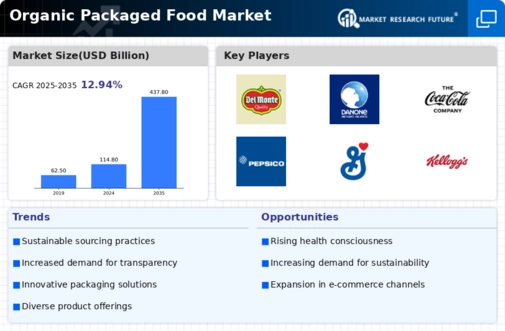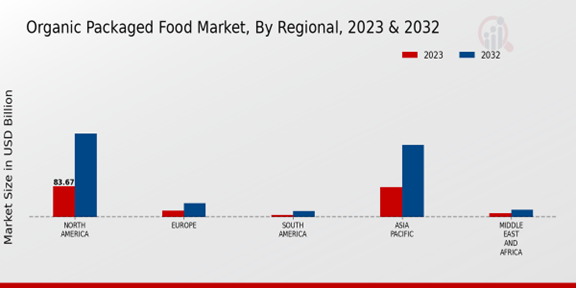Market Growth Projections
The Global Organic Packaged Food Market Industry is poised for substantial growth, with projections indicating a market size of 114.8 USD Billion in 2024 and an anticipated increase to 437.8 USD Billion by 2035. This trajectory suggests a robust compound annual growth rate of 12.94% from 2025 to 2035, reflecting the increasing consumer demand for organic products. The growth is likely driven by factors such as rising health consciousness, sustainability concerns, and government support for organic agriculture. As the market continues to expand, it may present significant opportunities for stakeholders across the organic food supply chain.
Rising Health Consciousness
The increasing awareness of health and wellness among consumers appears to be a primary driver of the Global Organic Packaged Food Market Industry. As individuals become more informed about the benefits of organic foods, demand for products free from synthetic pesticides and fertilizers rises. This trend is particularly evident in regions such as North America and Europe, where organic food sales are projected to reach 114.8 USD Billion in 2024. The shift towards healthier eating habits indicates a potential for sustained growth in the organic sector, as consumers prioritize nutrition and sustainability in their purchasing decisions.
Government Support and Regulations
Government initiatives and regulations promoting organic agriculture appear to play a crucial role in the Global Organic Packaged Food Market Industry. Various countries have implemented policies that support organic farming, including subsidies and certification programs. These measures not only enhance consumer trust but also encourage farmers to transition to organic practices. As a result, the market may experience accelerated growth, with projections indicating a compound annual growth rate of 12.94% from 2025 to 2035. This supportive regulatory environment is likely to foster innovation and investment in organic food production, further solidifying the industry's position in the global market.
Diverse Product Offerings and Innovations
The expansion of product offerings within the Global Organic Packaged Food Market Industry appears to cater to a wider range of consumer preferences. Companies are increasingly introducing innovative organic products, including snacks, beverages, and ready-to-eat meals, which appeal to health-conscious consumers. This diversification not only enhances market penetration but also stimulates consumer interest in organic foods. As the industry evolves, it is likely that new product lines will emerge, further driving growth. The continuous introduction of unique and appealing organic options may contribute to the industry's overall expansion, aligning with changing consumer tastes.
Sustainability and Environmental Concerns
Growing concerns regarding environmental sustainability seem to be influencing consumer preferences in the Global Organic Packaged Food Market Industry. Organic farming practices, which typically emphasize biodiversity and soil health, resonate with environmentally conscious consumers. This trend is likely to drive market growth, as more individuals seek products that align with their values. The market's trajectory suggests that by 2035, the industry could expand to 437.8 USD Billion, reflecting a significant shift towards sustainable consumption. As awareness of climate change and ecological degradation increases, the demand for organic packaged foods may continue to rise, reinforcing the industry's relevance.
Technological Advancements in Agriculture
Technological innovations in agricultural practices seem to be transforming the Global Organic Packaged Food Market Industry. Advances in precision farming, biotechnology, and sustainable farming techniques are enhancing the efficiency and yield of organic crops. These developments not only improve the availability of organic products but also reduce production costs, making organic foods more accessible to consumers. As technology continues to evolve, the market may witness increased competitiveness, potentially leading to higher sales volumes. The integration of technology in organic farming practices could play a pivotal role in meeting the growing demand for organic packaged foods.
























